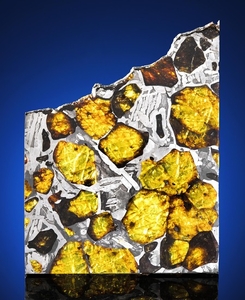FUKANG — EXTRATERRESTRIAL GEMSTONES IN MATRIX, Pallasite - PMG Fukang, Xinjiang Uyghur Autonomous Region – (44° 26'N, 87° 38'E)
This partial slice of a meteorite features a mosaic of sparkling olivine and peridot in a gleaming iron-nickel matrix. One side of the specimen is etched to reveal its metallic crystalline structure while the reverse has a high mirror polish. An edge of the meteorite’s external surface slopes across the top. Modern cutting and polishing.
101 x 79 x 2 mm. (4 x 3 x ⅛ in.) and 84.5 g.
A quintessential sample of the most beautiful extraterrestrial material known. Pallasites are not only rare, representing less than 0.2% of all known meteorites, they are also widely considered the most beautiful extraterrestrial substance known, and Fukang is among the most coveted. Recovered in China’s Gobi Desert, Fukang contains some of the largest and most translucent crystals of any pallasite. Comprised of approximately 50% olivine and peridot crystals suspended in 50% nickel-iron, main-group pallasites originated from the mantle-core boundary of a large planetary body between Mars and Jupiter that broke apart after an enormously energetic collision. The pallasite designation for this meteorite class is in honor of the German scientist, Peter Simon Pallas, who while traveling through Siberia, examined the first pallasitic mass in the early 1770s. This is an honor Pallas is fortunate to have received, for he fervently believed the unusual specimen he examined could not possibly have come from outer space.
Christie's would like to thank Dr. Alan E. Rubin at the Institute of Geophysics and Planetary Physics, University of California, Los Angeles for his assistance in preparing this catalog note.
View it on
Sale price
Estimate
Time, Location
Auction House
This partial slice of a meteorite features a mosaic of sparkling olivine and peridot in a gleaming iron-nickel matrix. One side of the specimen is etched to reveal its metallic crystalline structure while the reverse has a high mirror polish. An edge of the meteorite’s external surface slopes across the top. Modern cutting and polishing.
101 x 79 x 2 mm. (4 x 3 x ⅛ in.) and 84.5 g.
A quintessential sample of the most beautiful extraterrestrial material known. Pallasites are not only rare, representing less than 0.2% of all known meteorites, they are also widely considered the most beautiful extraterrestrial substance known, and Fukang is among the most coveted. Recovered in China’s Gobi Desert, Fukang contains some of the largest and most translucent crystals of any pallasite. Comprised of approximately 50% olivine and peridot crystals suspended in 50% nickel-iron, main-group pallasites originated from the mantle-core boundary of a large planetary body between Mars and Jupiter that broke apart after an enormously energetic collision. The pallasite designation for this meteorite class is in honor of the German scientist, Peter Simon Pallas, who while traveling through Siberia, examined the first pallasitic mass in the early 1770s. This is an honor Pallas is fortunate to have received, for he fervently believed the unusual specimen he examined could not possibly have come from outer space.
Christie's would like to thank Dr. Alan E. Rubin at the Institute of Geophysics and Planetary Physics, University of California, Los Angeles for his assistance in preparing this catalog note.



